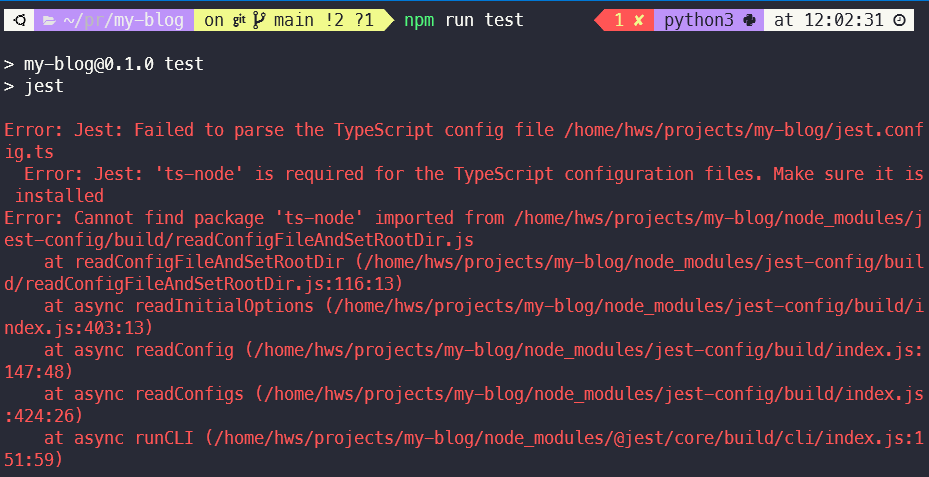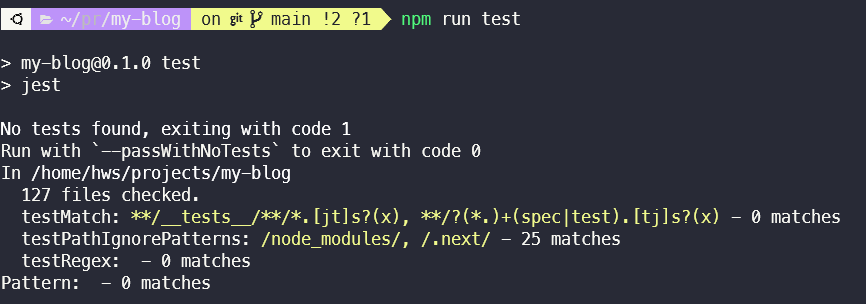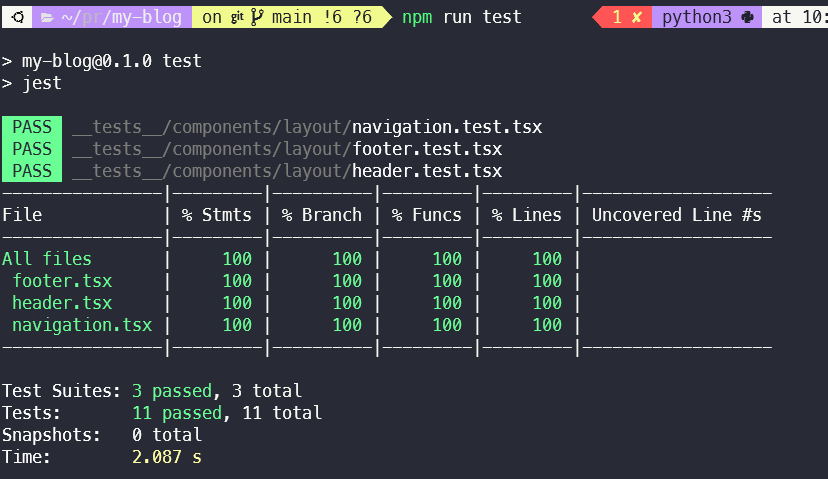Next.js에서 jest를 적용해서 테스트 코드를 작성해보자
2024.09.12 17:22
Overview
프론트엔드 환경에서 테스트 코드를 작성한 경험이 한 번도 없어 이번에 이미 만들어진 코드를 베이스로 시도해보기로 했다. (TDD 개발이었다면 테스트 코드를 작성하고 개발해야하지만 일단 넘어가자)
대상은 현재 NextJs로 만들어진 내 블로그에 적용해보기로 했다.
환경
- PackageManager: npm
- Next: 14.2.8
Getting Started
- Next 프로젝트를 생성하기 전이라면 아래 명령을 통해 간단하게 셋팅할 수 있다고 한다.
npx create-next-app@latest --example with-jest with-jest-app
하지만 나는 이미 next 프로젝트를 생성해서 내 블로그를 작업했으므로 수동으로 설정해줘야 한다.
Manual setup
# 필요한 라이브러리 설치 npm install -D jest jest-environment-jsdom @testing-library/react @testing-library/dom @testing-library/jest-dom
# jest initializing npm init jest@latest
jest init 할 때 여러 선택란이 주어지는데 나는 다음과 같이 설정했다. 안맞으면 수동으로 바꾸지 뭐 (참고로 environment 설정은 나중에 config 파일에서 jsdom으로 수동으로 변경했다ㅋㅋㅋ)

호기롭게 "좋았어! package.json에 jest로 test 명령도 추가됬겠다 한 번 돌려보자!" 하고 돌렸더니 터졌다.

다행히 아래 명령을 통해 ts-node 패키지 하나 설치해주니 테스트가 동작했다.
npm install ts-node --save-dev

Config Settings
tsconfig.json에 다음 부분을 추가하는 것을 잊지말자. 추가 안하니까 전역에서 jest를 인식하지 못했다.
// tsconfig.json { "compilerOptions": { ... "types": [ "jest", "node" ] ... }, ... }
jest.config.ts도 Next 공식 사이트의 해당 설정을 참고하며 수정했다. 참고
// jest.config.ts import type { Config } from 'jest' import nextJest from 'next/jest.js' const createJestConfig = nextJest({ // Provide the path to your Next.js app to load next.config.js and .env files in your test environment dir: './', }) // Add any custom config to be passed to Jest const config: Config = { coverageProvider: 'v8', testEnvironment: 'jsdom', setupFilesAfterEnv: ['<rootDir>/jest.setup.ts', '@testing-library/jest-dom'], } // createJestConfig is exported this way to ensure that next/jest can load the Next.js config which is async export default createJestConfig(config)
그리고 이 친구도 미리 설치하자. 안하니까 type을 인식 못해서 시뻘겋더라..
npm install --save-dev @types/jest
그리고 eslint에서 에러가 잡힐 수 있기 때문에 .eslintrc에도 살포시 jest 환경을 추가해줬다. (아오 뭐가 많네;;)
// .eslintrc.json { ... "env": { "jest": true }, ... }
됬다 여기까지 왔으면 얼추 기본 설정은 끝났다. 이제는 테스트 코드를 작성해보자.
테스트 코드 작성
간단한 단위 테스트 코드 구현을 위해 내 블로그의 navigation.tsx 컴포넌트의 기능이 제대로 동작하는지 테스트 하기 위한 코드를 작성했다.
해당 코드는 다음 기능을 검증한다.
- Home, Blog 텍스트를 가지는 링크가 존재하는가
- Home 링크는 '/'로 이동하는가
- Blog 링크는 '/posts'로 이동하는가
- 테마 버튼을 클릭하면 다크/라이트 모드 전환이 되는가
// __tests__/components/layout/navigation.test.tsx import '@testing-library/jest-dom'; import { render, screen, fireEvent } from '@testing-library/react'; import Navigation from '@components/layout/navigation'; import { useTheme } from 'next-themes'; import { usePathname } from 'next/navigation'; import React from 'react'; // next-themes mocking jest.mock('next-themes', () => ({ useTheme: jest.fn(), })); // next/navigation usePathname mocking jest.mock('next/navigation', () => ({ usePathname: jest.fn(), })); // next/link mocking - 자식 요소를 <a> 태그로 감싸도록 처리 jest.mock('next/link', () => { return ({ href, children }: { href: string; children: React.ReactNode }) => ( <a href={href}>{children}</a> ); }); describe('Navigation', () => { it('Home, Blog 링크가 존재', () => { // pathname을 '/'로 반환 (usePathname as jest.Mock).mockReturnValue('/'); // 현재 테마를 'light'로 반환 (useTheme as jest.Mock).mockReturnValue({ theme: 'light', setTheme: jest.fn(), }); // Navigation 렌더링 render(<Navigation />); // 텍스트 Home이 존재하는가 expect(screen.getByText('Home')).toBeInTheDocument(); // 텍스트 Blog가 존재하는가 expect(screen.getByText('Blog')).toBeInTheDocument(); }); it(`Home 링크 클릭하면 '/'로 이동`, () => { // pathname을 '/'로 반환 (usePathname as jest.Mock).mockReturnValue('/'); // 현재 테마를 'light'로 반환 (useTheme as jest.Mock).mockReturnValue({ theme: 'light', setTheme: jest.fn(), }); // Navigation 렌더링 render(<Navigation />); // 텍스트가 Home인 link의 href attribute가 '/'로 설정되있는가 const homeLinkElement = screen.getByRole('link', { name: /Home/i, }); expect(homeLinkElement).toHaveAttribute('href', '/'); }); it(`Blog 링크 클릭하면 '/posts'로 이동`, () => { // pathname을 '/'로 반환 (usePathname as jest.Mock).mockReturnValue('/posts'); // 현재 테마를 'light'로 반환 (useTheme as jest.Mock).mockReturnValue({ theme: 'light', setTheme: jest.fn(), }); // Navigation 렌더링 render(<Navigation />); // 텍스트가 Blog인 link의 href attribute가 '/posts'로 설정되있는가 const blogLinkElement = screen.getByRole('link', { name: /Blog/i, }); expect(blogLinkElement).toHaveAttribute('href', '/posts'); }); it('테마 버튼 클릭하면 다크 모드로 전환', () => { const setThemeMock = jest.fn(); // pathname을 '/'로 반환 (usePathname as jest.Mock).mockReturnValue('/'); // 현재 테마를 'light'로 반환 (useTheme as jest.Mock).mockReturnValue({ theme: 'light', setTheme: setThemeMock, }); // Navigation 렌더링 render(<Navigation />); // 테마 전환 버튼 클릭 const button = screen.getByRole('button'); fireEvent.click(button); // 'dark'가 반환되어 다크 모드로 전환되었는지 확인 expect(setThemeMock).toHaveBeenCalledWith('dark'); }); it('테마 버튼 클릭하면 라이트 모드로 전환', () => { const setThemeMock = jest.fn(); // pathname을 '/'로 반환 (usePathname as jest.Mock).mockReturnValue('/'); // 현재 테마를 'light'로 반환 (useTheme as jest.Mock).mockReturnValue({ theme: 'dark', setTheme: setThemeMock, }); // Navigation 렌더링 render(<Navigation />); // 테마 전환 버튼 클릭 const button = screen.getByRole('button'); fireEvent.click(button); // 'light'가 반환되어 라이트 모드로 전환되었는지 확인 expect(setThemeMock).toHaveBeenCalledWith('light'); }); });
테스트 결과
npm run test
test 명령을 수행하여 다음과 같은 결과를 얻을 수 있었다.

후기
지금은 이미 개발된 컴포넌트를 기반으로 테스트 코드를 작성해서 실행해봤다.
여기서 내가 느낀 점은 "어렵다. TDD로 개발하면 이런 테스트 코드를 어떻게 먼저 작성하고 실제로 개발하지?" 였다.
난 TDD에 공감이 잘 가지 않는 편이라 TDD가 무조건적으로 좋다라기보단 상황에 맞게 적용하는게 맞는 것 같다.
각 기능별로 컴포넌트를 개발하고나서 테스트 코드를 작성해서 실제 제대로 기능하는지 검증하는 용도로는 좋은 것 같다.
Reference
- https://nextjs.org/docs/pages/building-your-application/testing/jest
- https://jestjs.io/docs/getting-started